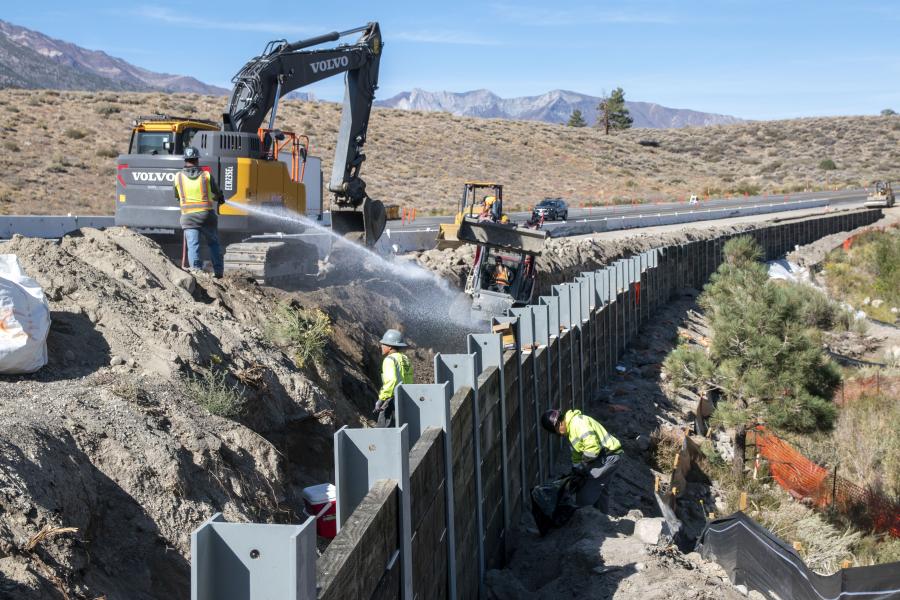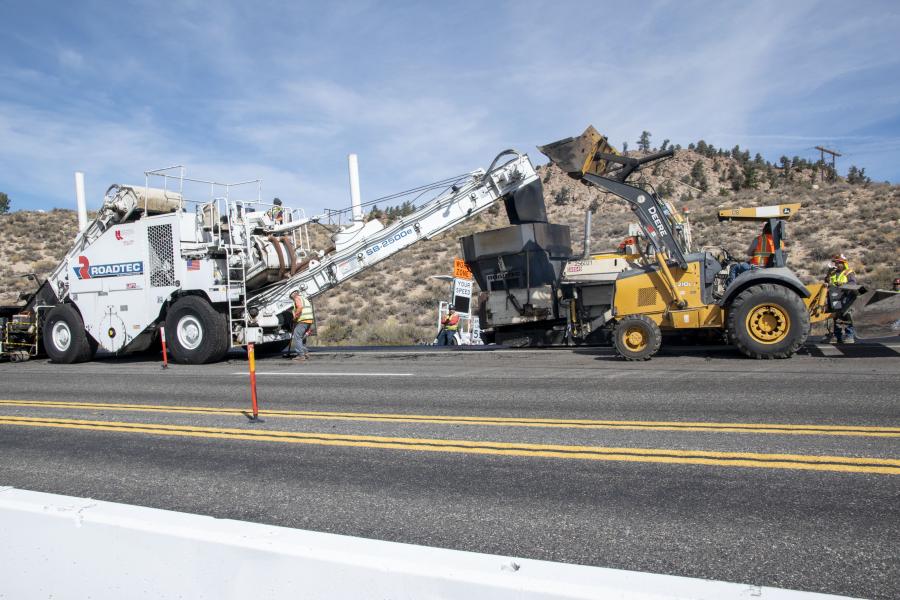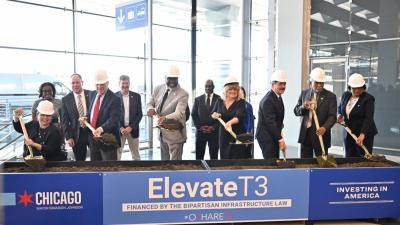On the Caltrans North Sherwin Shoulders Project, the design required altering the existing cut and fill slopes and adding retaining walls, all of which required extensive earthwork. Powell Constructors turned to a Volvo 235ECR hydraulic excavator to execute a critical part of the job.
(Photo courtesy of Michael Lindberg, Caltrans)
Powell Constructors Inc. began construction of the California Department of Transportation's (Caltrans) $21.4 million North Sherwin Shoulders Project in April 2021 in mountainous terrain more than 7,000 ft. above sea level on the east side of the Sierra Nevada mountain range.
The project, which spans from 2.4 mi. south of Lower Rock Creek Road to 0.3 mi. north on U.S. Highway 395 at the top of Sherwin Grade in Mono County, features the widening of 5.4 mi. of shoulders that range from 2 to 4 ft. to a consistent 10 ft. of shoulder throughout the construction area. The upgrades will help to increase safety and decrease the number of traffic incidents on the highway.
In addition to widening the paved highway shoulders to 10 ft. and improving sight distances around curves, crews also are installing retaining walls, flattening soil slopes next to the highway, replacing or installing guardrails, upgrading drainage systems, installing skip rumble strips between travel lanes and shoulders and adding a bicycle right turn pocket at U.S. 395 and Lower Rock Creek Road.
This project is anticipated to be completed by the end of October.
"To accommodate the wider shoulders, the project design required altering the existing cut and fill slopes and adding retaining walls, all of which required extensive earthwork," said Mike Powell, president of Powell Constructors. "The earthwork was done with excavators and bulldozers that included a Volvo 360 excavator and a John Deere 450 bulldozer. There was no blasting."
Engineering Challenges
Powell addressed some of the engineering challenges.
"The side slopes in the region are primarily composed of decomposed granitic soil with cobble and large rock," he said. "The project was sustainably designed as a balance project where material excavated in one location was used for fill in another area of the project. This improved the overall roadway for safety beyond the pavement and reduced trucking and disposal of material costs, a more environmentally friendly strategy.
"Before construction began altering slopes, the topsoil, including native plants and vegetation, was pushed to the side of the slopes and was stored in duff piles along the project. Upon completion of the slope improvements, the topsoil will be replaced and the vegetation in these duff piles ground up and spread on the new slopes, enhancing new plant growth."
Due to the elevation of the project location and as a major lifeline, commercial and recreational route for the Eastern Sierra, the general contractor had to plan its work accordingly.
"During construction activities, one lane in each direction was closed completely to traffic for earthwork operations and wall construction," said Michael Lingberg, public information officer, Caltrans District 9.
"Work operations were scheduled from 7:00 a.m. to 5:00 p.m. Monday through Friday. At this elevation, work will typically go into winter suspension when ambient temperatures are not within specifications for paving. Additionally, soil disturbance is prohibited above 5,000 feet in elevation between October 15 and May 1 due to regulations of The Lahontan Regional Water Quality Control Board. For long-duration suspensions, the contractor was required to open the entire roadway back to traffic and take precautions to allow Caltrans maintenance crews to remove snow during the winter while remediating stormwater issues that could arise from the winter snow. Work could only resume when temperatures returned to favorable conditions and after May 1."
Before the winter suspension last November (November 2021 to May 2022), Powell Constructors built six walls, performed some grading of the cut slopes and paved a portion of the new northbound shoulders. After emerging from winter suspension on May 2, it constructed the remaining two walls, finished grading the cut and fill slopes, paved the remaining shoulders and installed guardrail. It still has to complete permanent erosion control, install rumble strips and restripe the highway. Most of the drainage improvements on the North Sherwin Shoulders project happened this season, following the winter suspension.
Eight walls were constructed throughout the project area. Four of them were soldier pile walls that support the roadbed for the widened 10-ft. shoulders and four are barrier walls that hold back slopes at sensitive geological features. The soldier pile walls are supported with 16-ft. steel I-beams.
"Crews drilled shafts into the ground with a Cat 330 excavator complete with a Watson drilling attachment and then placed the beams into the shafts," said Powell. "They were then backfilled with concrete. Pile drilling was a challenging procedure when crews encountered granite rock, cobble, boulders and water."
Other large equipment used on the project includes: a Volvo 305ECR hydraulic excavator, a Volvo 235ECR medium crawler excavator, a Cat D6 dozer, a Cat 950M loader, a Peterbuilt 4,000-gal. water truck, a Bayshore DH20 drill rig, a Geax DTC30 drill rig, a Cat 415F skip loader and a Takeuchi TL12v2 skid steer paired with FAE UML.SSL-150 mulching head,
"The main challenges on this project stemmed from labor shortages," said Powell. "Our labor force was faced with higher living expenses while in Mono County. To remedy this, we provided housing to our workers. However, even with the incentives, it was difficult to bring in additional help from outside sources due to the remote location compared to larger population centers where there is adequate work closer to where people live.
"Another challenge was logistics. Major support and material must be trucked in from larger cities such as Los Angeles, Bakersfield or Reno, all of which are three to six hours away. This distance affected the maintenance of equipment on the job. The main wear and tear issue for these machines stemmed from the dulling of the wear edges when they contacted rock."
Powell praises the efforts of his crews and Caltrans staff.
"We could not have succeeded with this project without the efforts of our outstanding key employees who have been with us for many years," he said. "The Caltrans District 9 staff was a breath of fresh air. The communication amongst the team is top notch. The morale of the crews was challenging at times, which is to be expected. They are working long hours and have been away from their families. We appreciate everything they have done and are doing to complete this project."
Peak days had many Powell Constructors and subcontractor employees on-site. Local and regional contractors were brought on board.
The tallies for the excavation and demolition operations — earth and rock, concrete, steel and asphalt are still being tabulated, as are the amounts of new materials —concrete, steel, and asphalt.
Powell Constructors purchases and rents equipment from local and regional dealerships.
Project Need
The roadway is a four-lane facility on a major route between Los Angeles and Reno, on the east side of the Sierra Nevada. Lower Rock Creek runs underneath U.S. Highway 395 near the northern end of the project. During winter storms, Caltrans maintenance crews spread cinders on the roadway to increase vehicle traction in snowy and icy conditions.
"The project's main goal is to increase driver safety and decrease the number of traffic incidents through the area by widening the shoulders and center median throughout the project," said Lingberg. "The widened shoulders will not only improve safety for errant vehicles, but it provides room for bicyclists. During winter storms, the wider shoulder allows additional room for snow storage after snow is removed from the roadway. Stormwater features designed to trap traction cinders used during winter storms were installed throughout the project to protect the nearby creek."
Powell Constructors submitted a bid of approximately $13.5 million and was awarded the construction contract on Feb. 4, 2021. The company specializes in constructing bridges, roadways, retaining walls, drainage improvements and all other associated aspects of highway infrastructure.
The project was designed by Caltrans.
"This project will greatly improve safety along this section of U.S. Highway 395 in Mono County," said District 9 Deputy District Director of Engineering and Surveys Bryan Winzenread. "Increasing the shoulder width gives errant vehicles a stable, wider surface for recovery and allows greater separation from bicyclists, making travel safer for everyone. I am proud of the hard work and dedication of everyone involved." CEG
Today's top stories























